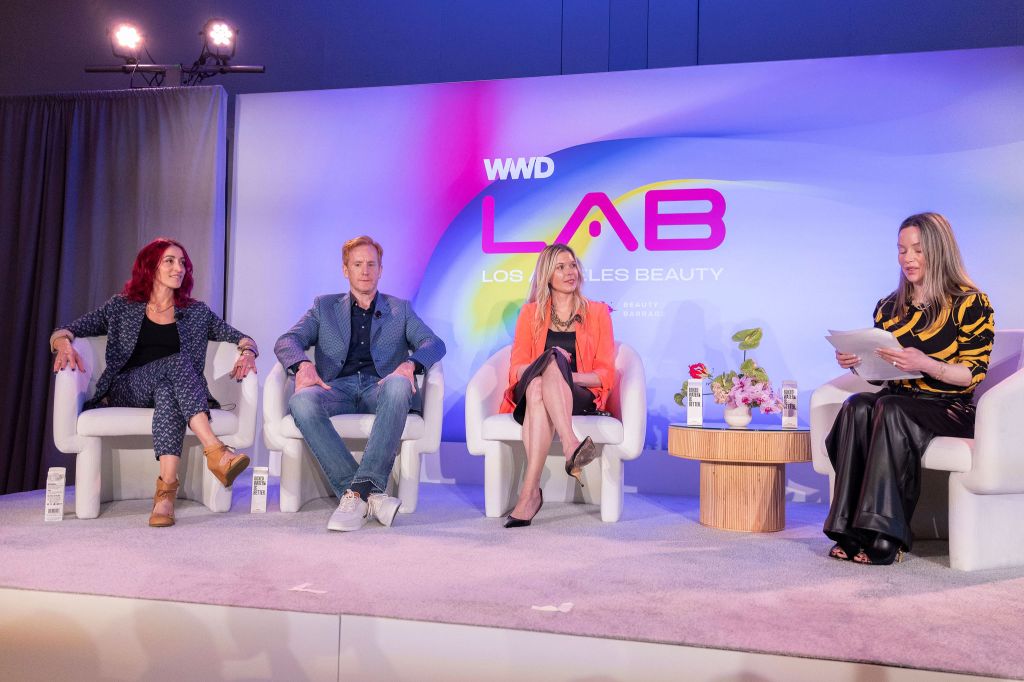“How do you get invited to that happy hour?”
That was the question on everyone’s minds after hearing self-described members of the “Bay Area beauty mafia” share nuggets of investing wisdom — and details about their regular happy hour parties —at LAB.
“I think this is the longest we’ve been together without opening a bottle of wine,” joked Kevin Murphy, managing director of Sonoma Brands Capital, a Sonoma, Calif.-based private equity firm whose present and past portfolio includes Merit, Versed, Avaline and Tarte. “San Francisco has a great lineage with Sephora, Benefit and a whole list of others, but the most enjoyable part is people are getting on airplanes now to swing by…and it makes you enjoy being in a category with such fun and cool people.”
Related Articles
Tina Henry Bou-Saba, cofounder of Verity Venture Partners, opened the panel conversation (not the wine) by asking Murphy, Rebecca Bartlett and Liz Whitman to share insight about how to set your investor playbook on fire, the landscape for capital, and the common mistakes early-stage founders make. Here are their top takeaways:
On launching an independent beauty brand and how it has changed:
“It’s gotten incredibly challenging over the past five years,” said Whitman, founder of clinical skin care line Exponent Beauty, a career beauty operator who previously ran Red Door by Elizabeth Arden and a third-time entrepreneur. “On the one hand, the investment macro environment has made it so we need to operate efficiently. But on the other hand, the marketing brand and landscape being what it is, the cost to acquire customers has completely skyrocketed. These things are at odds.”
Whitman shared three tips for navigating the tricky landscape. The first is meaningful product differentiation in a very cluttered beauty landscape. “In Exponent’s case, we invest in clinical skin care technology,” Whitman said. “But for other brands that could be developing products that solve previously underserved needs are customer concerns or customer segments.”
A multifaceted distribution strategy is number two. Whitman noted that established beauty retailers are still important — but increasingly competitive, meaning brands need to broaden their thinking. “For Exponent, we are a clinical skin care line so we actually have a pro line we sell through professional channels, like spas, med spas and dermatologists offices,” she said, “while we focus on our consumer line in traditional beauty wholesale. For other lines, like Halsey and About-Face, it might be music festivals. So wherever you have a creative advantage,” she said.
Whitman’s third tip was to home in on customer loyalty and repeat purchasing. “I’m talking about that gobsmacking-make-my-heart-soar, I want to yodel about your brand from every mountain top type of customer passion,” she said, noting that Exponent’s antiaging serum has been its hero. “She’s seeing real results, so she’s coming back for more. And now we need to broaden our clinical skin care technology to take care of her additional concerns. For other brands, it might be a strategy of limited drops or brand collaborations that keep their customers delighted on a consistent basis.”
On raising funding and building a brand to last:
“I think about building a business as a series of chapters. And each one of those chapters has a building phase, a validating phase and a double-down phase,” Whitman said. “What we’ve always tried to do is structure our capital raises around raising capital to fund the double-down phase of the current chapter, as well as the build and validate phase of the next one.”
As an example, she cited the early days of Exponent, when the business was bootstrapped with the aim of achieving two key goals: To do third-party research on the degradation of actives in skin care products, the problem Whitman was trying to solve with the creation of the brand, and to create a prototype of her envisioned solution.
In those early days, Whitman also looked to “validate that the dogs would eat the dog food” with consumer focus groups. “Are people going to want this solution? Are they gonna go for it,” she said. “And it was only at that moment that we went to go raise a pre-seed round to fund the rest of our R and D journey.”
That round of funding went to a variety of tasks: manufacturing, tooling, proprietary formulas, clinical studies, IP protection. “Branding was a huge part of that as well,” Whitman said, “and fortunately, we had investors who were able to see that even though it’s an unusual trajectory and upfront investment that that would pay off because it creates a sustained product differentiation over time.”
On the funding environment today:
“We’re sort of back to where it might have been 12 to 15 years ago, where brand story, founder vision, the consistency and durability of what a founder sees in the future has become more important,” Murphy said. “The period where tactics began to compete with brand not just because of the DTC dynamic, but largely because of that, are over.”
The availability of capital:
As popular as the beauty category has become for investors, the landscape reflects macro realities. “Relative to a few years ago, capital has tightened up a bit,” Murphy said. “But there’s a great community out there now of founders who have had successful exits who not only have capital, but also have insight and desire to help the next wave of brands. So there are pockets of capital. And what I love to see is more patient capital like that, you kind of come in while the brand is still in that divining period, you’re listening for signaling, you’re not just trying to be too commercial.”
What investors are looking for:
“We’re looking for a commercial validation in places to be sure, but not as much as people would think. We’re really looking for the tightest consistency of why somebody brought a brand into the world,” Murphy said. That’s romantic, of course, “but then also tactical — the hiring, some of the mechanical decisions that really reflect that kind of the true north. That’s always been important, but it sort of took a backseat to performance marketing and things like that for a while. Now it’s back.”
On building relationships with prospective investors in advance of fundraising:
It’s essential, Murphy said. “Because even the best-performing investment in the best-performing brands, there are always tough times.…You want to be able to pick up the phone and call your investor with bad news. You don’t want to dread it, you want that help, you don’t want that admonition and punishment. You won’t really know that unless you spend time in different weather patterns and on different days to really understand how these people think. Building relationships means spending time asking about people, getting on a plane, doing things that are social, doing things that are work oriented, and doing your best to gauge how these people are going to act when things aren’t going well.”
Critical inflection points for investor-backed startups launching:
The inflection points are based on the profile of clients, said Bartlett, principal and creative director of creative marketing and brand building agency Bartlett Brands, which has worked with Paula’s Choice, Playground Sexual Wellness and Exponent, among other brands.
“Profile one is innovation brands where you have true R&D, you’re reinventing the world with a new product or new packaging.…There’s a massive amount of money that’s being raised before a brand sees the light of day, and sometimes it takes three years to bring something like this to market and millions of dollars. Branding is always part of that early stage, the brand never launches without being a brand, fully dressed and ready to go.
“Profile two is a founder or brand that’s targeting a different consumer or carving out their white space, but not necessarily reinventing the wheel. Those brands we often see straddling investment…but eventually you kind of come to this point where you have a chicken and an egg, if you don’t have a brand, you can’t raise money. And you can’t launch a brand without tapping capital. As any founder will tell you, the amount of capital that you need to get out in the world to acquire consumers and to pay for production is just astronomical.”
The biggest pitfall for founders:
“Grossly underestimating what it takes to bring a brand to life,” Bartlett said. She often counsels founders to take it one step at a time, noting that often her firm will help fledgling brands with branding strategy and differentiation, “and helping them communicate that really effectively…where they can talk the talk to investors, the investors can be very impressed by their thoughtfulness. And then they hit that raise and they’re able to roll out their vision,” she said.
How to balance the patience to build a brand with pressure from investors:
“I suggest to founders that they stretch their significant capital raising as long as possible because once certain types of capital come in, there are expectations,” Murphy said. For his part, Murphy looks beyond the exit. “The way I try to solve for that is…just falling in love with a story or a brand, but not putting the thought into jeez, how long is this going to take?” he said. “Because the last thing you want is for an investment mandate, or for expectations, to get in the way of development of a brand. The only way to avoid that is to be as honest as you can as an investor with yourself. And then as honest as you can with the brand founder to make sure that you’re not setting one another up for friction,” he said.
“Things can take a while, if you look at some phenomenal brands it took 10 years to get to $7 million or $8 million — some of which are many multi $100 million brands,” Murphy said. “Every brand is different, every founder is different, and sometimes brands can scale quickly and sometimes they need that patience. And if capital begins to wag the dog, then somebody messed up.”
On scaling to the profitability required for an exit without institutional investment:
“I’m a founder, so I’m wired to be very open minded to the art of the possible. I wouldn’t say it’s impossible, it just depends on everyone’s journey, time horizon, patience to build systematically and capital requirements at different stages of the business,” Whitman said. “For us, from an R&D perspective, it was critical to find investors that understood the longer term horizon and the longer term payoff and wasn’t going to put pressure on us to be something that we couldn’t be in those first three research and development years. But ultimately, it’s important to understand that investors, whether those are funds, strategic angels, whoever you bring to the table, the really good ones are more than just to check, and they actually help you succeed and get to where you want to go faster.”



